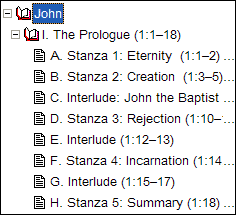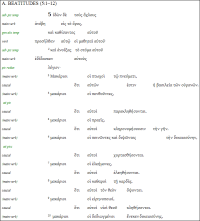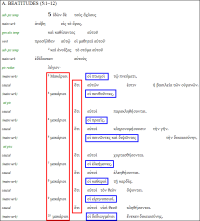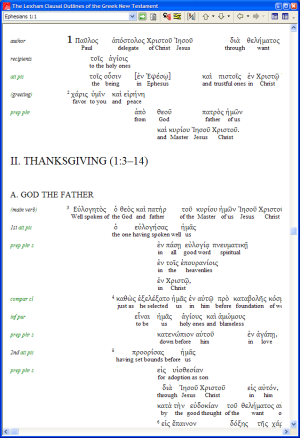I’ve blogged a lot about new resources and capabilities in the realm of Greek syntax over the past months.
One piece of that puzzle that I haven’t blogged about at all is a work that is called The Lexham Clausal Outlines of the Greek New Testament by Dr. Dean Deppe of Calvin Theological Seminary.
Part structural outline, part block diagram and part clausal annotation, this is a unique work that preachers and expositors will find helpful as they examine larger chunks of the Greek New Testament in preparation for teaching and preaching or for personal study.
Let’s examine a few passages and see what sort of information the Clausal Outlines provide.
John 1.1-18
One thing we see upon examining the first chapter of John is that the first 18 verses have been divided into a structure of five “stanzas” with three interludes:
- Stanza 1: Eternity (1.1-2)
- Stanza 2: Creation (1.3-5)
- Interlude: John the Baptist (1.6-9)
- Stanza 3: Rejection (1.10-11)
- Interlude (1.12-13)
- Stanza 4: Incarnation (1.14, 16b)
- Interlude (1.15-17)
- Stanza 5: Summary (1.18)
This gives a clue to the structure of the passage as analyzed by Dr. Deppe. So some suggestion as to structure is provided.
Additionally, clausal annotation and some block-style diagramming is available.

The column on the left reflects basic annotation by Dr. Deppe. In this case, he has noted that the current structure contains main verbs (see next example below for some better examples of this column’s usage). The text is broken up vertically and horizontally, and within each line is divided into groups or units.

You can see the repeated elements (??, ? ?????, ???? ??? ????, and ?? ????) much more easily than you would if just the printed or normally formatted electronic edition was being evaluated. Using Dr. Deppe’s arrangement, you’re more likely to note these sorts of things: Where the same verb is used and repeated, where similar prepositional phrases are used in close sequence, where similar vocabulary is used things like that.
Matthew 5.1-12
Not all outlines offer the same level of detail as that of the first portion of John 1.1-18. The Beatitudes (Mt 5.1-12), for example, are treated as one section. Click on the thumbnail graphic below to see the arrangement.
You can again immediately see some things in common in the structure; there’s more that I haven’t highlighted.
As has been discussed before on this blog regarding syntactic and grammatical information, there are many different dimensions to cover. As such, any one presentation will fall short if it has complete and comprehensive coverage and annotation as its goal. Dr. Deppe’s work does not purport to be an end-all, be-all block diagramming solution. Rather, the text is presented in the order found in the UBS4 edition with horizontal and vertical spacing to draw attention to some of the larger trends that Dr. Deppe noted when working through the text. This, combined with the concise clausal annotation, makes for a resource (when the interlinear lines are turned on and arranged how you want them, like the image below) that can be of tremendous value in working through a passage to determine how to preach it, or how to teach the major points to a class or small group.
Dr. Deppe has even included examples of usage for the outlines of Ephesians and Colossians. This will help familiarize you with how he uses the work, what sorts of things he looks for, and how he applies the information to preaching and teaching.
This resource is available in the current Logos Bible Software 3.0 beta version, though that edition has an unfortunate error in implementation on my part. A completely revised edition (reflected in the above screen captures) will be made available with the next beta release of Logos Bible Software.








